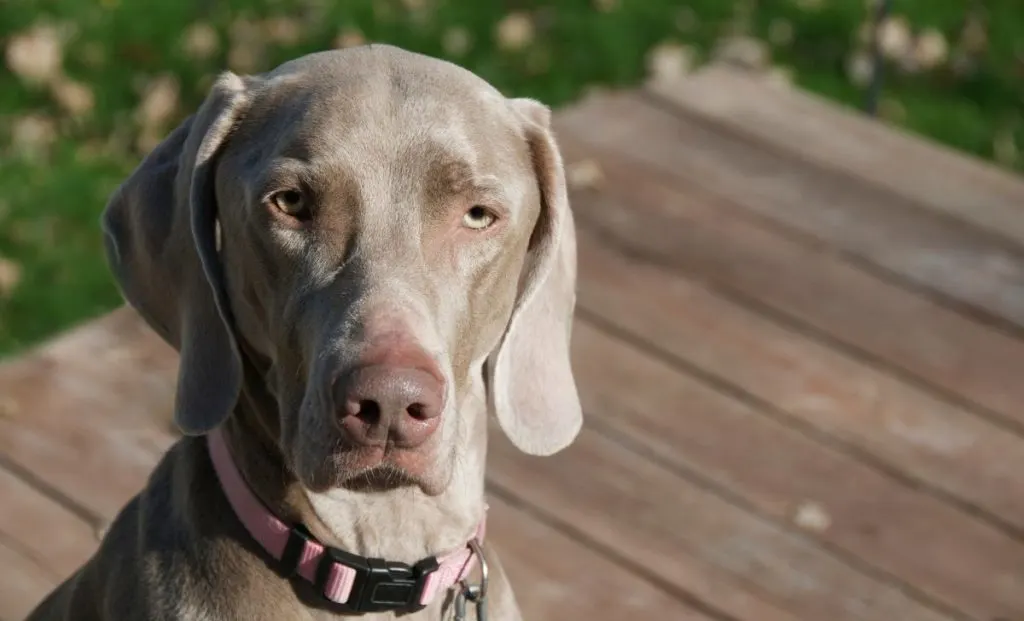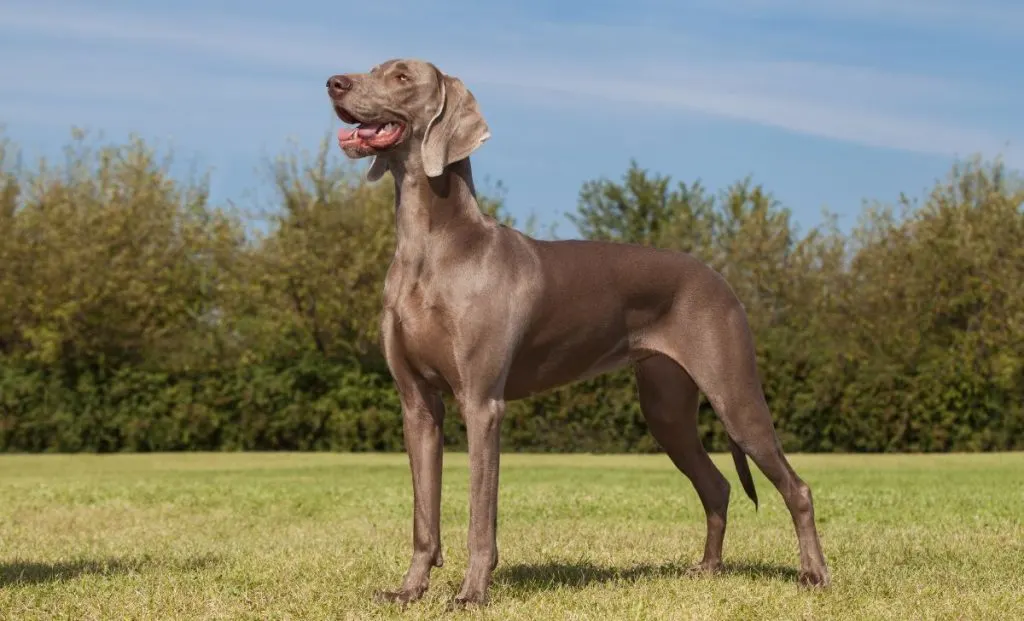Also known as the Gray Ghost, this gun dog is known for its good looks and obedient personality. But did you know there are several Weimaraner colors in addition to the well-known blue?
This incredible breed originated from the German city of Weimar, which is how it got its name. Weimaraners today have many resemblances to these old dogs, and its breed standard was set back in 1891.
According to the American Kennel Club (AKC), the Weimaraner can come in a few different colors. The breeders sell even more shades, some of which are allowed and others that are not.
So, just how many Weimaraner colors are out there and which ones are safe to get?
Here’s everything you need to know!
1. Gray Weimaraner

The classic Weimaraner is known to come in various shades of gray.
This specific gray coat color is the product of unique genetics. To be more precise, these are brown dogs with a specific dilution gene.
This dilution gene affects the brown pigment, giving it a light chocolate color. As a result, the dog’s brown base coat, nose,and paw pads, are in a cold brown hue.
If you don’t believe me that these dogs are white-washed brown pups, just look at the dog’s nose! You’ll see that it isn’t really gray but rather taupe.
Gray Weimaraners typically have light blue eyes, another striking feature this breed is known for.
This is one of the most desirable Weimaraner colors out there. However, its exact hue can be challenging to predict. The same litter of puppies can produce gray Weimaraners in different shades.
Most desirable gray Weimaraners are somewhere in the mid-range between dark and light hues.
2. Mouse Gray Weimaraner

These are dark gray Weimaraners, and they are the only recognized variety of the gray coat.
Mouse Gray Weimaraners are dark taupe in color, which is a perfect contrast to their blue eyes.
They are a true example of all the color differences in gray Weimaraners. Despite their color being caused by the same dilution gene, they look quite different from standard gray Weims.
3. Silver Gray Weimaraner

Silver Weimaraners, also known as silver gray, is yet another color variety of gray Weimaraners.
These are the lightest Weimaraners, with their shade being almost as light as white.
Their coat is light taupe, perfectly blended with blue eyes and brownish-taupe noses.
Sadly, you cannot register your Weimaraner as silver gray, but the AKC will accept it under the name ‘Gray Weimaraner’.
4. Blue Weimaraner

The last coat color accepted by the AKC is the blue Weimaraner.
Blue Weimaraners are quite different from previously mentioned gray ones. This is because they are actually black dogs with a dilution gene. This gene affects all the black pigment in the dog’s body. Most notably, it will turn its black coat into a beautiful blue color.
Also, not only are their eyes blue, but their nose, as well! This is the main difference between blue and gray Weimaraners.
Unfortunately, this color appearance is not always a good thing. The blue dilution gene is connected with some health concerns – most notably, color dilution alopecia (CDA).
The good thing is that CDA is not dangerous and is usually just an aesthetic issue. Also, it is quite rare even in blue dogs, so most blue Weims are perfectly healthy.
5. Light Blue Weimaraner
The light blue coat is not recognized by the AKC on its own, but these dogs can be registered as standard blue Weimaraners.
They have the same blue Weimaraner genetics, but their color appears much lighter. Just look at this adorable pup and how gentle his color scheme is!
On rare occasions, these pups are as light as silver Weims. However, their noses will always be blue instead of brown/taupe.
6. Dark Blue Weimaraner

The dark blue Weimaraner is simply a blue Weim that comes in a darker shade.
AKC doesn’t recognize these minor color differences, but the good thing is that this means you can still register your pup.
They are quite similar to mouse gray Weims, but their noses are blue.
Also, their eyes can sometimes be dark blue instead of that bright shade Weimaraners are known for, but this is considered undesirable.
7. White Blaze Weimaraner
Any Weimaraner can be white blaze! The only color difference between this and any other Weimaraner is that these pups have a tiny white spot on their chest or chin.
These markings are undesirable but allowed, as long as there aren’t too many of them or if they aren’t too big. If this does happen, the dog will be disqualified from participating in dog shows. Chances are you won’t even be able to register them.
8. Piebald Weimaraner

Piebald Weimaraners are quite rare. Many people don’t even know they exist and confuse them with some other dog breeds – most notably, German Shorthaired Pointers, considering how piebald is one of their main colors.
These pups have a white base coat and numerous colored markings and spots on their bodies.
However, piebald is not a standard Weimaraner color. No reputable breeder will intentionally breed piebald Weims, considering how there are some indications that the pattern might be connected with a few health concerns.
Also, the presence of such a pattern might be an indication that you’re actually looking at some Weimaraner mix and not a purebred dog.
9. Tan Markings Weimaraner

While most Weimaraners are solid colored, some have barely visible tan markings on their body – typically on their face and chest.
Considering how tan markings aren’t affected by dilution genes, they will always be present on the dog’s body, no matter if they’re blue or silver.
However, as the contrast between tan and blue or gray is quite minimal, you might not even notice them at first.
Tan markings are considered a fault and are not allowed in the breed. Still, they aren’t a certain indication your pooch has been crossbred, as they can appear naturally in the breed.
10. Brindle Weimaraner

Brindle is not a true color but rather a pattern. It consists of a base coat – typically a brown color – and tiger-like stripes.
These stripes are usually black but can be dark brown or even blue if the dilution gene is present.
White markings are also quite common with these pups, even more so than in other colors.
As gorgeous as these pups are, this isn’t a standard Weimaraner color and is typically a sign that a dog has been crossbred.
Weimaraner Coat Types
Next to all these beautiful colors, Weimaraners also come in a few coat types.
Not only will this affect your pup’s appearance, but also the type of coat care.
All Weimaraners are medium to large dogs – take a look at their growth chart to see just how big they can be!
However, with a big size comes a big responsibility in terms of brushing their coats. Understanding the type of their coats can greatly help with this and make your life so much easier.
Here are the 3 Weimaraner coat types:
Short Haired Weimaraner

This is the standard Weimaraner we all know and love.
The shorthaired Weimaraner has a very short single coat that requires no trimming and very little care. Just don’t forget about regular brushing, as this can help deal with loose hairs and dander.
Also, while it might look the part, this isn’t a hypoallergenic dog. There are many things that cause dog allergies, not just dog hair, so if you struggle with dog allergies, you might want to check some Poodle mix instead.
Longhaired Weimaraner

Most people have never seen a longhaired Weimaraner before. This isn’t surprising, as they are so rare.
As their name says, these pups have a long coat that is the result of a recessive gene. This means that two short haired Weimaraners can give longhaired offspring if both carry this gene.
They also have a double coat, which means they shed quite a lot. This means they require lots of grooming and brushing.
Long Haired Weimaraners are not accepted by the AKC. However, most other kennel clubs, such as the United Kennel Club (UKC) and the Federation Cynologique Internationale (FCI) accept both short haired and longhaired varieties.
Stockhaar Weimaraner

Lastly, you have stockhaar Weimaraners, the rarest of all three types. Also, this is the one type that isn’t recognized by the largest kennel clubs, which is one of the reasons behind its rarity.
They are typically the result of breeding a short haired Weim with a long haired one, although most such puppies will end with either a short or long coat.
Their coats are not short but not as long as in longhaired Weimaraners – rather somewhere in between.
Also, stockhaar Weims have only one layer of coat, just like short haired Weimaraners. However, the hairs themselves are much longer, especially on the tail, shoulder, ears, and neck.
This pup is easier to brush and maintain from longhaired varieties but still requires regular grooming.
Can Weimaraners Be Brown?
As mentioned earlier, all Weimaraners have a brown base coat that is diluted to blue and gray. But can brown still appear in this breed?
It is believed that the original Weimaraners had a brown coat. However, all modern Weimaraners have the dilution gene and cannot come without it.
In fact, some experts state that Weimaraners are the result of breeding Vizslas or German Shepherd Pointers with breeds that have the dilution gene so that it could enter the breed’s gene pool.
Today, breeding brown Weimaraners is considered unethical, as these pups are crossbreeds – they were bred back with Vizslas or GSPs to make the dilution gene disappear.
So, if you see someone selling a brown Weim, don’t fall for that scam. These pups aren’t called the Gray Ghost for nothing.
Does Color Even Matter?
Looking at all these Weimaraner colors, it’s no wonder Weims are considered one of the most beautiful dog breeds out there! But does their coat color affect anything else?
Breed standard colors are a sign that the pup is most likely healthy and purebred. They are one of many indications that the breeder is doing a good job and conducting all the necessary health testing to ensure all of their litters are in the best possible condition.
If you get a dog that doesn’t look like its breed standard, you are most likely dealing with a mixed breed. A good example is a brindle Weimaraner, which is almost always a clear sign your dog has been crossbred.
This can not only alter its appearance but also affect the Weimaraner’s needs.
All dogs need a balanced diet, the right amount of exercise, and proper grooming to make sure their general health is perfect. If you get a mixed breed without realizing it, you might not take the best care possible of him.
Also, these pups might not behave how you expect them to, so you might end up with a dog that is not a good fit for you.
Of course, there is nothing wrong with getting a mixed breed – as long as you’re fully aware of this.
Other than that – you can feel free to choose whichever Weimaraner color you like the best.
All of these pups make excellent working dogs, and with some work, they can even be great family dogs. The beautiful color is just a welcome bonus.

Vanja’s passion for writing started at an early age, which is why she pursued Journalism as her college degree. She can research any topic and find all the information before you bat an eye, which is a great thing for her job but a terrible one for her husband.
Even as a young child, she fell in love with everything fluffy – but dogs have a special place in her heart due to her childhood companion, a Corgie named Archie.
Motivated by her experiences and driven by a desire to give back to her four-legged companions, she spends her free time volunteering at a local dog shelter.
